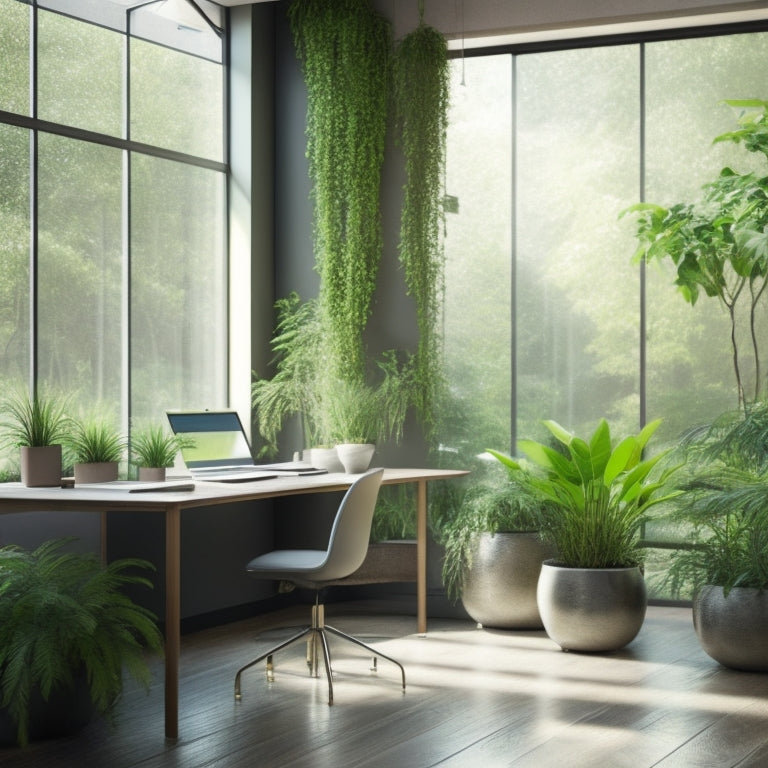
Clean Office Air: Natural Purification Methods Explained
Share
You're taking a proactive approach to creating a healthier workspace by utilizing the power of natural air purification methods. Utilizing nature's air purifiers, like plants, can effectively remove pollutants and toxins from the air, while also adding aesthetic appeal. Activated carbon filters and UV light purification methods can also capture impurities and eliminate airborne contaminants. Natural ventilation strategies, such as cross ventilation techniques, can enhance indoor air quality without relying on mechanical systems. By exploring these natural purification methods, you'll be well on your way to breathing easier and working healthier - and that's just the beginning of creating a truly clean office air environment.
Key Takeaways
- Harnessing nature's air purifiers, like plants, can effectively remove pollutants, toxins, and allergens from the air, improving indoor air quality.
- Activated carbon filters capture impurities and odors through adsorption, providing a non-invasive method for air purification.
- Natural ventilation strategies, such as cross ventilation, can enhance indoor air quality without relying on energy-intensive systems.
- Incorporating plants like spider plants, aloe vera, and peace lilies into office design can provide aesthetic appeal while improving air quality and humidity control.
- Implementing sustainable office design principles, including the use of eco-friendly materials and natural textiles, can promote a healthier indoor ecosystem.
Harnessing Nature's Air Purifiers
By relying on natural air purifiers, you can markedly reduce indoor air pollution without resorting to chemical-laden products or energy-intensive devices.
This approach allows you to create a healthier indoor ecosystem, where air quality is improved through non-invasive means. Incorporating solar-powered solutions, such as solar energy for EV charging, can also contribute to a cleaner environment.
Natural air purifiers can effectively remove pollutants, toxins, and allergens from the air, promoting a cleaner and fresher environment.
By incorporating these natural solutions into your daily life, you can breathe easier, think clearer, and enjoy a better quality of life.
Effective Plant-Based Solutions
Among the most effective natural air purifiers, plants stand out for their ability to remove pollutants and toxins from the air.
By incorporating renewable energy solutions, such as solar power for EV charging, into our daily lives, we can further reduce our carbon footprint and promote a cleaner environment.
When selecting plants for air purification, you'll want to choose species that excel in toxin removal, such as spider plants, aloe vera, or peace lilies.
These plants provide growth benefits, like improved air quality, while adding aesthetic appeal to your office. They also help with humidity control and are often pest-resistant.
To keep your plants thriving, follow simple maintenance tips, like watering and fertilizing regularly, and provide seasonal care, like pruning and repotting.
Place your plants in areas with suitable light requirements, and consider office placement to maximize air purification.
Activated Carbon Filters Explained
You're likely familiar with activated carbon filters, but do you know how they actually work to purify the air you breathe?
As you'll soon uncover, these filters rely on a unique process to capture impurities and odors, making them a popular choice for natural air purification.
In fact, much like sustainable charging solutions Renewable Energy Sources, activated carbon filters utilize natural processes to remove pollutants.
How It Works
Through the intricate process of adsorption, activated carbon filters capture pollutants and odors, rendering the air cleaner and fresher. You benefit from this natural air purification method as it removes impurities, allowing you to breathe easier.
As air passes through the filter, it undergoes biological filtration, where microscopic organisms break down pollutants. This process enhances air exchange, replacing stale air with fresh, clean air.
By shifting to sustainable fuel options, such as electrification and biodiesel, we can reduce greenhouse gas emissions. The activated carbon's vast surface area enables it to trap particles, gases, and volatile organic compounds (VOCs), leaving your office air feeling revitalized.
Filter Maintenance Tips
Proper maintenance of your activated carbon filter is vital to guarantee its effectiveness in purifying the air. You need to confirm your filter is working at its best to remove impurities and pollutants.
Depending on the filter type, you may need to replace it every 3-6 months. To optimize energy production and reduce costs, it's essential to select energy-efficient equipment, which can minimize energy losses and reduce operating costs.
Regularly cleaning your filter can also help maintain its performance. Check the manufacturer's instructions for the recommended replacement frequency. Make sure to follow the cleaning instructions provided to avoid damaging the filter.
Odor Removal Capacity
Within the domain of air purification, activated carbon filters boast an extraordinary capacity for odor removal, making them an indispensable component in maintaining a fresh and healthy indoor environment.
Ideal energy production from solar panels, such as those used in solar EV charging stations, is vital for powering these filters efficiently solar panel array design.
You'll find that these filters employ advanced odor absorption techniques to capture and neutralize unwanted scents. As air passes through the filter, odor molecules are attracted to the activated carbon's vast surface area, where they're trapped and eliminated.
This scent neutralization strategy is particularly effective against volatile organic compounds (VOCs) and other airborne irritants.
UV Light Purification Methods
You're now considering another natural air purification method: UV light purification. This technology employs ultraviolet light to eliminate airborne contaminants, and it's crucial to understand how it works to leverage its germicidal effects effectively.
With the growing demand for sustainable solutions, it's worth exploring how UV light purification can complement Fast Charging Infrastructure in promoting eco-friendly practices. By integrating energy-efficient designs and renewable energy sources, UV light purification can further reduce carbon footprint.
How UV Light Works
As you investigate the domain of natural air purification methods, it is essential to understand how UV light works to eliminate airborne pathogens and pollutants. UV technology employs specific light wavelengths to target and neutralize microorganisms, improving indoor air quality. This process involves the emission of ultraviolet radiation, which interacts with the DNA of airborne pathogens, rendering them inactive.
| UV Light Characteristics | Purification Effects |
|---|---|
| UV-C (254nm) | High germicidal effectiveness against bacteria and viruses |
| UV-A (365nm) | Effective for surface sterilization and air purification |
| UV-B (280-315nm) | Contributes to purification efficiency, but with lower germicidal effectiveness |
Germicidal Effects Explained
Your air purification system's germicidal effects rely on UV light's ability to interact with microorganisms, rendering them inactive or destroying them entirely.
This interaction occurs when UV light penetrates the cell walls of microorganisms, damaging their DNA and disrupting their ability to replicate. As a result, UV light purification methods exhibit strong germicidal properties, making them effective in disinfectant applications.
By utilizing the power of UV light, you can create a cleaner and healthier environment. UV light's germicidal effects are particularly useful in eliminating airborne pathogens, bacteria, and viruses that can spread illness.
Safe Usage Guidelines
When incorporating UV light purification methods into your air purification system, it's essential to confirm safe usage to maximize effectiveness and minimize risks.
You must verify proper installation, maintaining a safe distance between the UV light and occupants. Direct exposure to UV light can be harmful, so it's vital to follow safety protocols.
Regularly inspect and maintain your UV light purification system to prevent overheating, which can compromise air quality.
Additionally, replace UV lamps according to the manufacturer's guidelines to maintain peak performance.
Natural Ventilation Strategies
Effective natural ventilation strategies capitalize on wind and temperature differences to remove stale air and introduce fresh air, creating a healthier indoor environment.
As you design your office space, consider implementing cross ventilation techniques that allow air to enter and exit through windows, doors, and vents on opposite sides of the building. This approach optimizes airflow, reducing stagnation and promoting a consistent exchange of air.
You can further enhance airflow optimization by strategically placing furniture and partitions to minimize obstructions and maximize air circulation.
Air Quality Monitoring Essentials
Monitoring indoor air quality is essential to maintaining a healthy and productive workspace, as poor air quality can lead to a range of negative health effects, from mild discomfort to severe respiratory issues.
You need to track air quality metrics, such as particulate matter, nitrogen dioxide, and ozone levels, to identify pollutant sources and assess health impacts.
To do this effectively, you'll require:
- Advanced monitoring technology that provides real-time tracking and data analysis.
- Assessment tools that help you interpret air quality indices and comply with standards.
- Knowledge of indoor pollutants, such as volatile organic compounds and carbon monoxide.
- A system for continuous monitoring and data analysis to guarantee a safe and healthy work environment.
Non-Toxic Cleaning Alternatives
You've taken the first step in maintaining a healthy workspace by monitoring indoor air quality.
Now, it's time to tackle cleaning practices that can compromise the air you breathe. Traditional cleaning products can release harmful chemicals into the air, negating your efforts to maintain a healthy environment.
Switch to eco-friendly products that are free from harsh chemicals and toxins. Create a cleaning schedule that targets high-traffic areas and prioritizes tasks based on importance.
Incorporate natural cleaning methods, like microfiber cloths and white vinegar, into your daily routine. By adopting these non-toxic cleaning alternatives, you'll greatly reduce indoor pollution and create a safer, healthier workspace for everyone.
Eliminating Indoor Pollutants
By identifying and eliminating sources of indoor pollution, you can greatly reduce the amount of airborne toxins in your workspace. This is vital for maintaining good indoor air quality, as pollutant sources can have serious health impacts.
Toxins like particulate matter, chemical fumes, and allergens can aggravate respiratory issues and even cause long-term damage.
Some common sources of indoor pollution to eliminate include:
-
Moisture accumulation: Fix leaks, use a dehumidifier, and guarantee good ventilation to prevent mold growth.
-
Chemical-laden cleaning products: Switch to non-toxic alternatives to reduce chemical exposure.
-
Poor air filtration: Upgrade to a high-efficiency air filter to capture more pollutants.
- Inadequate ventilation: Improve ventilation efficiency by opening windows or installing a ventilation system.
Sustainable Office Design Tips
Now that you've tackled pollutant sources, it's time to focus on designing your office space to promote natural air purification.
You can create a haven for clean air by incorporating eco-friendly materials and biophilic design principles. Choose materials with low VOCs (volatile organic compounds) to minimize emissions. Opt for natural textiles, reclaimed wood, and recycled materials to reduce waste.
Biophilic design, which emphasizes connections to nature, can also enhance air quality. Incorporate plants, natural light, and ventilation to create a healthy, breathable environment.
Frequently Asked Questions
Can Air Purifiers Remove All Types of Pollutants From the Office Air?
You think air purifiers are superheroes that can vanquish all pollutants, but sadly, no. They can't remove all types of pollutants, but they can greatly improve office air quality by tackling common culprits like particulate matter, gases, and volatile organic compounds.
How Often Should I Replace the Air Filters in My Office?
You should replace your office air filters every 1-3 months, depending on usage and air quality, to maintain effective filter maintenance and guarantee ideal indoor air quality, promoting a healthy and productive work environment.
Are Natural Air Purification Methods Effective for Large Office Spaces?
As you breathe in, imagine fresh air circulating freely, like a gentle breeze on a summer day. You'll find natural ventilation and strategic plant selection can effectively purify the air in your large office space, providing a healthier environment for you and your colleagues.
Can I Use Scented Candles or Essential Oils to Purify the Air?
You're considering scented candles or essential oils to purify the air, but unfortunately, they're not effective air purifiers; they may even introduce pollutants, and their fragrances can trigger health issues, so it's best to investigate alternative methods.
Are Air Purification Systems Noisy and Distracting in the Office?
You'll find that many air purification systems are designed to operate quietly, with minimal office noise, ensuring low distraction levels, allowing you to focus on your work without interruptions, while still enjoying clean air.
Related Posts
-

7 Best Automated Sprinklers for Water-Wise Green Homes
You're likely among the 75% of U.S. homeowners who use in-ground sprinkler systems, and coincidentally, you're also c...
-

Why Vertical Gardens Reduce Home Energy Consumption
By incorporating a vertical garden into your home design, you'll reduce energy consumption through natural insulation...
-

10 Best Sustainable Waste Management Solutions for Green Homes
You're likely unaware that the average green home generates over 2 kilograms of waste daily, but with the right susta...


